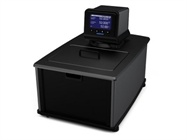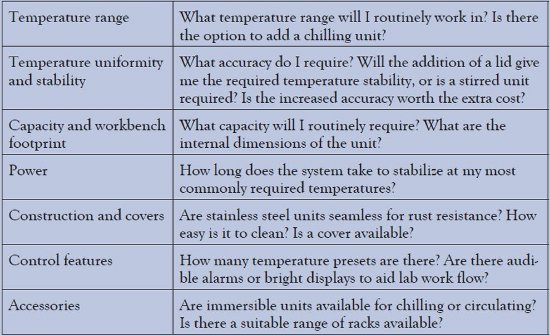Featured Article

Please check out our Water Baths and Recirculating Chiller sections for more information or to find manufacturers that sell these products
Water baths and chillers are used to heat or cool liquid samples and maintain them at a constant temperature. They are ideal for substances that cannot be exposed to direct heat, such as flammable liquids or biological materials.
Water baths consist of a container that heats or cools a bath of fluid to the required temperature. The samples, usually in glass vials, are placed into the bath to be heated or cooled.
Water baths and chillers are very widely used in labs, and there is a broad range of choices from different manufacturers. Equipment ranges from basic water baths for thawing and heating to digitally controlled stirred heating and chilling units with the option of adding shaking, ultrasonic, or external circulating capabilities.
Some key purchasing considerations of a water bath are listed in Table 1. These include:
- Temperature range
- Temperature uniformity and stability
- Capacity and workbench footprint
- Power
- Construction and covers
- Control features
- Accessories.
Additional systems include:
Table 1 – Overview of purchasing considerations

Temperature range
The temperature range is dependent on the heating and chilling technology of the unit and on the fluid used in the bath (see Table 2). For basic water baths, the temperature range is typically (ambient +5) °C to 99.9 °C.
Table 2 – Temperature range of fluids used in water baths

To reduce the temperature to ambient or lower, it is necessary to use a chiller. Most chillers will cool down to about –25 °C, but some equipment, such as the GLACIER Series G50 Ultra-Low Refrigerated Circulators from Thermo Fisher Scientific (Waltham, MA) will take samples down to a temperature of –50 °C. Many manufacturers offer a separate immersion chilling accessory that can be added to a heated water bath to add chilling capability.
Boiling water baths take samples to 100 °C. The high temperature oil bath from Grant Scientific (Hillsborough, NJ) has a working temperature range of +50 °C to 260 °C.
Waterless baths use dry metallic beads instead of a fluid. This makes it easier to avoid contamination, and removes the need for shelves or racks since vessels can be supported by the beads themselves. Beads from Lab Armor (Cornelius, OR) have a working temperature range of –80 °C to 180 °C. Note that it is important to use only fluids recommended by the manufacturer for a particular bath.
Temperature uniformity and stability
Requirements for temperature uniformity and stability will depend on the application of the water bath. Unstirred water baths rely on convection currents, and as a result will never achieve a very high degree of temperature uniformity. Basic unstirred water baths such as the Isotemp economy water baths from Thermo Fisher Scientific offer uniformity and stability of ±0.2 °C at 37 °C with a cover. For the majority of applications, temperature stability within ±0.2 °C is sufficient, and minor fluctuations of uniformity of temperature across the reservoir will not cause problems.
Greater temperature uniformity can be achieved with a stirred water bath. Stirred baths use either a magnetic mechanism or a circulation pump to agitate the fluid to avoid temperature gradients.
Entry-level stirred water offer a high degree of temperature accuracy. The T100 series from Grant Scientific have a stability of ±0.05 °C and a uniformity of ±0.1 °C.
Increased temperature accuracy corresponds to a significant price increase, mostly due to the expensive thermometers required for accurate measurement. The Grant Optima™ TXF200 is one of the most accurate water baths on the market, with a stability of ±0.01 at 70 °C and a uniformity of ±0.05 at 70 °C.
Capacity and workbench footprint
The capacity of water baths and chillers varies greatly. Choosing the right size is a question of efficiency in terms of time to stabilize temperatures, cost of electricity to run the unit, and amount of workbench space the unit occupies.
The TW2 unit from JULABO (Allentown, PA) has a capacity of only 2 L and is designed to take one test tube rack. Its dimensions are just 17 × 16 × 26 cm (W × L × H) and it weighs only 3.5 kg. (7.7 lb). By contrast, Parameter Generation & Control (Black Mountain, NC) offers a 50-gallon water bath that includes external circulating capability.
When choosing the capacity of a water bath, check the internal dimensions as well as the overall volume so that you can be sure the unit will accommodate the number of samples you require.
Power
 Figure 1 – The 15L Heated Circulating Bath from PolyScience is fully programmable with a touch screen, choice of 11 languages, and the ability to connect to the Ethernet. (Image courtesy of PolyScience.)
Figure 1 – The 15L Heated Circulating Bath from PolyScience is fully programmable with a touch screen, choice of 11 languages, and the ability to connect to the Ethernet. (Image courtesy of PolyScience.)The power of the water bath affects the heating and cooling rate, and therefore the time it takes for the bath to stabilize before it can be used. Ask to see the manufacturer’s gradient charts for heating and cooling. PolyScience (Niles, IL) publishes its Circulating Bath Heating and Cooling Performance charts online, showing the heating and cooling rates for different capacity units. A circulating water bath from PolyScience is shown in Figure 1.
Construction and covers
The construction of the water bath affects the cost, performance, and longevity. Some entry-level water baths are constructed from plastic; these are less expensive, but are not suitable for boiling applications. Most units are constructed from stainless steel.
A robust, durable construction will add to the longevity of the unit. You can expect your water bath to last for five years, but if it is well cared for, it can last over 10 years.
Where temperature uniformity and stability are important, or high temperatures are required, it is important that the unit includes a cover.
Control features
Basic water baths include analog controls. Digital controls give additional accuracy and the opportunity to have preset temperatures.
Some manufacturers include audible alarms that sound if the bath temperature exceeds preset limits.
JULABO water baths include alerts for unsupervised operation, such as bright LED displays that can be seen across the lab, plus dry-running protection with an audible and optical alarm.
Accessories
Many manufacturers offer immersion chilling or circulating units that can be added to a standard heated water bath. Check that the manufacturer offers a suitable range of racks for your chosen capacity of water bath. Racks are typically made of stainless steel. Polyfoam floating racks are also available, making it easier to use different-sized test tubes in the same reservoir.
Additional systems
External circulating systems
External circulating water baths are used to export controlled temperature fluids to an external closed system such as a photometer, refractometer, or viscometer. The water bath is used as a reservoir and the temperature-controlled fluid is pumped to the sample.
Shaking water baths
Shaking water baths, also known as reciprocating water baths, are typically used in biological applications such as hybridization and cell or bacterial culturing. The shaking is operated through the action of strong magnets. A typical RPM range is 20–200, with a temperature range of (ambient +5) °C to 99 °C. Some manufacturers offer an independent shaking platform that can be added to your standard water bath. Some shaking platforms offer the choice of linear or orbital shaking action. Others offer adjustable stroke length.
Ultrasonic baths
Ultrasonic baths are mainly used for high-performance cleaning of laboratory equipment, but are also used for cellular breakdown, degassing, sonochemistry, dispersion, and fluid dissolution. A good ultrasonic water bath will feature accurate process control of time, temperature, ultrasonic activity, degas, and power.
For more information on water baths and chillers, please visit www.labcompare.com.
Katriona Scoffin, B.Sc., is a freelance science writer; e-mail: [email protected].
Please check out our Water Baths and Recirculating Chiller sections for more information or to find manufacturers that sell these products